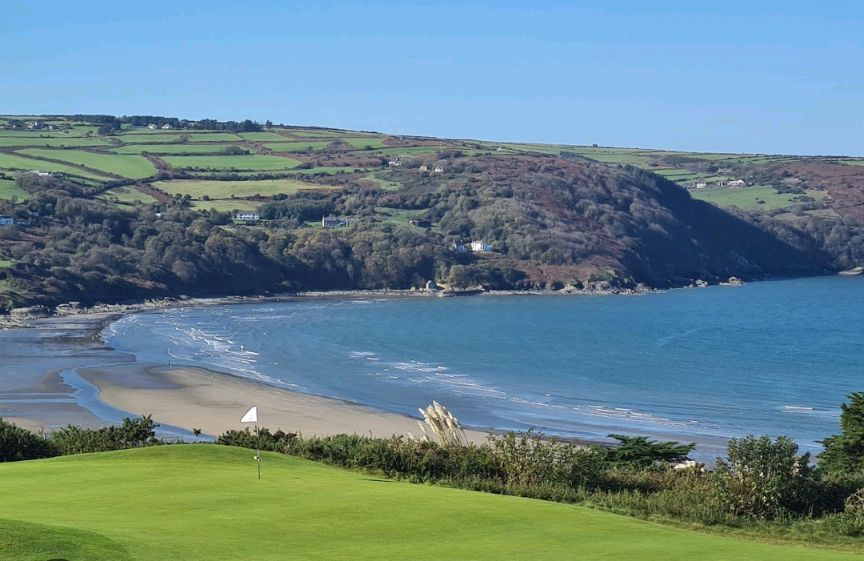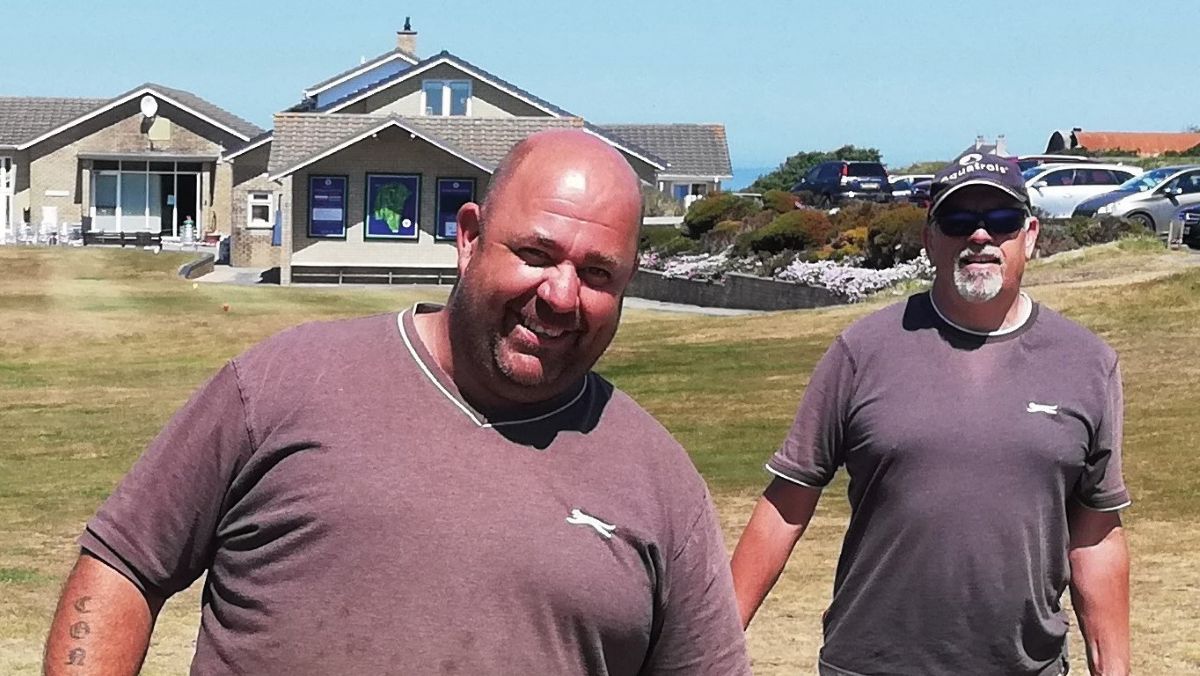- Homepage
- News and Features
- Stuart Adams - Wales' Top Greenkeeper Thrives at Cardigan
Stuart Adams - Wales' Top Greenkeeper Thrives at Cardigan
The Wales Golf Greenkeeper of the Year is perfectly at home at the clifftop links, with the full support of the club and a dedicated team under his care.

Stuart Adams exudes the kind of infectious enthusiasm that can’t help but put a smile on your face. Asked how he got his start in greenkeeping, he barely pauses for breath as he recounts his entire career - deviating occasionally from the main thread to weave in some other salient detail as he paints the vivid picture of a man who loves his job.
It is clear that Stuart’s energy and expertise have been fundamental to the ongoing rise of Cardigan, which in 2023 was named Wales Golf Club of the Year. The man himself was honoured with the Wales Golf Greenkeeper of the Year Award in March in recognition of his outstanding work at the clifftop links that enjoys stunning views over Cardigan Bay.
Stuart’s commitment to sustainability has seen Cardigan become a shining example of how to work with nature while producing exceptional playing surfaces conducive to the environment. He joined the club in 2017 and it was in March the following year that the last fungicide application went down, while inputs of nitrogen, pesticide and water have been vastly reduced.
Fescue to the rescue
The course boasts pristine fescue surfaces after a carefully managed sward transition that has elevated the playing experience and aligned the turf conditions with the natural environment. That was a key objective of Stuart’s from day one.
“In the first greens meeting I said you can chase speed through low cuts or go back to the indigenous plant that should be on the course, and we run with fescue,” he explained. I told them the first thing that we’ll need to do is lift the cutting heights, which was received with a bit of a gasp from the committee, because they obviously wanted faster greens. I explained that the way to get these greens faster is if we change cultivars, we species select and start pushing back to the fescue.
“There’s no magic to it – it’s just persistence and understanding the needs of fescue.”

Despite the inevitable initial drawbacks, the short-term pain proved to be worth it in the end, with evident results after little more than a year.
“The first 12 months were rough, with greens slowing down, but we pushed through with faith from the committee and membership,” said Stuart. “We were aiming for a kind of sustainable greenkeeping before it really became fashionable. Within 12 months, the greens were transformed back to a pure fescue surface at 6mm through winter and 4mm through summer. Some of our biggest critics in year one became our biggest fans in year two.”
The club’s blossoming reputation as a fine venue and welcoming host has seen a number of Wales Golf events staged there, including the Welsh Team Championships, Junior Championships, Women’s Seniors Championships and the Wales v Ireland juniors on a biannual basis.
Sustainability first
Sustainability is at the forefront of the greenkeeping team’s work at Cardigan, and it goes far beyond maintaining the playing surfaces. Stuart embraces a holistic approach that supports the idea of greenkeepers as guardians of the land, entrusted as stewards of the environment. While that is unquestionably a significant responsibility, it doesn’t necessarily mean taking on more work.
“With low resources and limited staffing, you start to prioritise the most important jobs,” he said. “When [former BIGGA ecologist] James Hutchinson came in 2019, his consultancy walk reinforced everything I believed about austere greenkeeping – using nature to take the forefront. He showed us areas that we were managing that didn’t need to be managed. The hardest thing for greenkeepers is to do nothing, but nature will thrive if left alone. We’ve implemented cut and collect systems, reduced nitrogen inputs and slowed cutting regimes. By doing less, we’ve encouraged wildflowers, orchids and natural ecosystems.
“It’s about understanding where management is needed and where it isn’t. We’re not controlling nature, we’re guiding it. Every decision is about working with the environment, not against it.” The club depends on local ground-sourced water fed through a network of five rain catchment ponds, gravity-fed to a pump house, while an on-site turf nursery is used for winter project work to include 33 revetted bunkers, the sand for which is locally sourced.
Valued staff
Skilled as he may be in agronomy, Stuart puts a high value on how he manages people – regarding them, not the turf, as the most important part of his role. Having realised early in his career that a passion for greenkeeping can lead to the job encroaching on personal commitments, Stuart is a firm believer in affording staff – himself included – a favourable work-life balance.

“I know many passionate greenkeepers who will comfortably do 70-80 hours a week to try to get the course to a certain level,” he said. “But if you don’t get that work-life balance correct, you’re going to miss out on the things away from work – and they’re the very reason why we work in the first place.”
Providing staff with opportunities to learn and progress is also something close to Stuart’s heart as he wants to reinforce the idea that greenkeeping is a career, and not a stop-gap job. On that front, as with all others, he has the full backing of the club.
“I’m fortunate I have a team full of career greenkeepers and I’d say they’re probably some of the best I’ve ever worked with, because they believe in what they’re doing,” he said. Any CPD that they’ve asked for, my committee has been absolutely key and said yes right along the way. I don’t think I’ve ever gone into a greens meeting and asked for a spring course refresher, or a chainsaw refresher, or a level two for the starters, and been told, ‘No’. Pushing education from the top down to my level and then down to the team’s level has been utterly key to make all this work.”
Stuart himself went back to college at the age of 39 to gain his HNC and HND through distant learning at Elmwood as an R&A Scholar, setting an example to his own children about the importance of education.
Delegation’s what you need
A lesson Stuart has learned since moving to Cardigan is knowing when to take a step back and let others assume responsibility for tasks. It empowers them to learn, gives them a sense of ownership and provides a course manager more time to focus on the aspects of the role that only they can execute. He believes that the whole team dynamic is what led to him being named Wales Golf Greenkeeper of the Year.

Stuart's team Gareth Earles, greenkeeper; Jac Davies, apprentice; Paul Legg, part-time greenkeeper; Henry Malloy, part-time greenkeeper; Casey Walters, assistant greenkeeper (weekend worker)
“I think delegation is absolute key,” he said. “It’s the hardest lesson that I’ve had to learn since I’ve been at Cardigan Golf Club. I sat in on a seminar at BTME where a gentleman was talking about how micromanaging is not good. It’s about actually handing over ownership and getting the boys passionate about what they do. You show them how and then allow them to take responsibility for their work.
“The reason we’ve got this award is because I’ve got a fantastic team around me. They do go the extra mile and I don’t need to be leaning over their shoulders – they’re almost self-governed. The moment a head greenkeeper takes all the credit when things are going right, and can’t learn about taking the blame when things go wrong, you’ve lost balance. It’s about making sure the boys get the credit, and the compliments are fed back to the team.
“In that spirit, this award was for the whole team, and all of Cardigan Golf Club – I couldn’t do what I do without them.” GI
Stuart’s approach: Sustainability
- Promoting the surfaces that will thrive in the environment
- Low inputs in nitrogen, pesticide, water
- Locally sourced, STRI-recommended
- Using natural resources responsibly and effectively
- Working within financial boundaries to ensure long-term security
Manage fescue, do not be surprised when fescue grows
Within the sward I now alternate seed companies to allow eight separate fescue cultivars to grow, furthering the hardiness of the green sward. Predominantly six slender creeping red and two chewing fescues overseeded with Vredo twice yearly. I would like to run more but need to be budget and time aware. A six-monthly check of profiles matched on the laptop allows me to monitor thatch levels and if thatch stays under control, hollow tining will be put on hold. The natural bents within the green now are adequate to allow a good mixture of species for harder-wearing greens through the winter. The greens still need a small amount of brushing/grooming early in the season to allow the fescue to continue to thrive and Poa seeds to be removed. I am fully aware of the disturbance theory of fescue but at times, good greens are about balancing the right operations with the managed species.
Stuart’s approach: Managing upwards
- Course walks with both green staff and management
- Future-proofing the golf course with long-term planning reports
- Involving committees with seminars and meetings within the industry
Stuart’s approach: Managing staff
- Inclusive workplace where staff can be proud of the difference they make
- Ongoing opportunities to learn and progress
- Rewards and recognition along the way
- A real understanding of work-life balance
- Focus on retaining and developing staf
Career Timeline
Author

